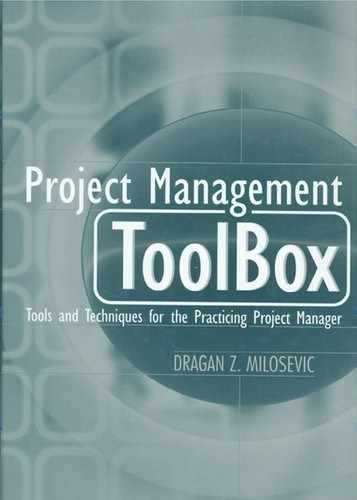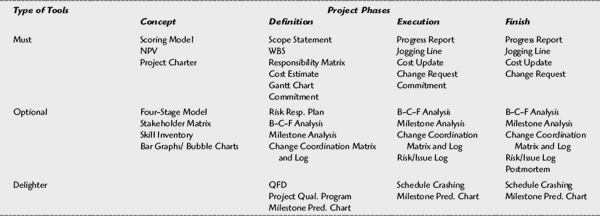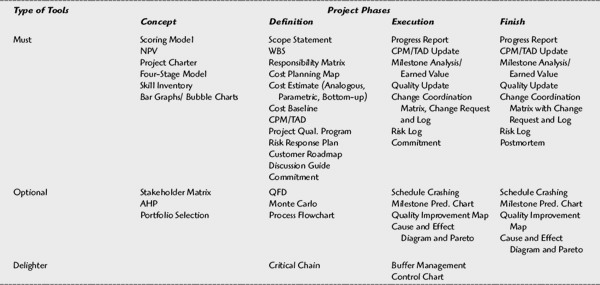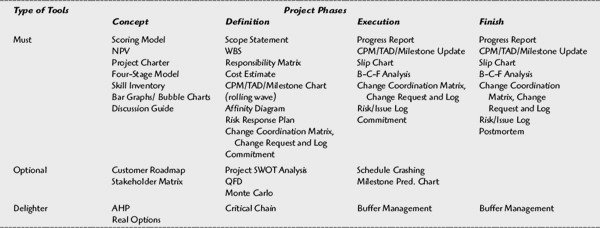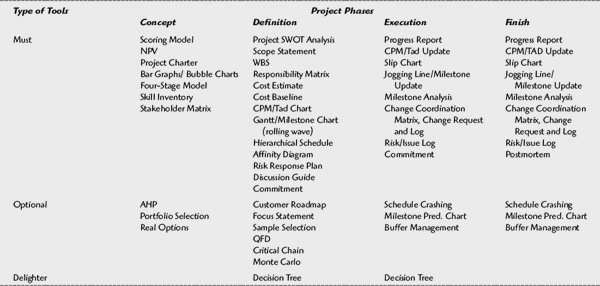D
Project Management Toolboxes per Project Type
The discussion in Chapter 16 indicated that some organizations might favor customization of the PM toolbox by the project type. Typically, such organizations have lots of projects that significantly vary in size but also in technical novelty, spanning from low tech to high tech. Also, they may see this customization type as a unifying framework for all types of their projects—from facilities to product development to manufacturing to marketing to information systems. For these organizations, this appendix offers examples of the toolboxes for the following project types:
- PM toolbox for routine projects
- PM toolbox for new administrative projects
- PM toolbox for technical projects
- PM toolbox for unique projects
While definitions of these project types are provided in Chapter 16, our goals in presenting the toolboxes are as follows:
- Goal 1: Show only PM tools
- Goal 2: Tier each project type's toolbox into more and less important tools
- Goal 3: Describe how some PM tools have to be adapted
Goal 1: Show PM Tools Only
Because these project types are of an across-industry, across-project-family nature, we show only PM tools in the toolbox, leaving out technical deliverables, as well as managerial deliverables that the tools support. You can readily use the examples as an adaptable blueprint and add your technical and managerial deliverables to form the PM toolbox for your organization. As you do that, you should first read our criteria for defining the four project types. If your criteria are different, you should adapt the offered examples of the toolboxes accordingly.
Goal 2: Tier Each Project Type's Toolbox into More and Less Important Tools
Here we again use the Kano methodology to divide each project type's toolbox into must, optional, and delighter tools. These types of tools are defined in Appendix B.
Goal 3: Describe How Some PM Tools Have to Be Adapted
In Chapter 16, Figure 16.5 we showed examples of several PM tools—scope, schedule, cost, and risk planning tools—that have to be adapted to account for different SPM (standardized project management) processes in the four types of projects. These tools are presented in each of the following toolbox examples. Later in this appendix we provide more details on the adaptation.
The Toolbox for Routine Projects
The Toolbox for Administrative Projects
The Toolbox for Technical Projects
The Toolbox for Unique Projects
Adapting Project Management Tools for Four Types of Projects
Scope, schedule, cost, and risk planning tools shown in Figure 16.5 in Chapter 16 and also included into the all examples of toolboxes in this appendix have to be adapted per requirements of SPM processes in the four types of projects. In the following, we describe the adaptation. Similar adaptation may be necessary for other tools in these toolboxes, as well as for toolboxes developed with other types of customization—customization by project size and customization by project family.
Routine Projects. With their low complexity and technical novelty, routine projects need a precise Scope Statement that will be based on a well-defined scope that is frozen before or early in the execution phase of the project. That enables us to use a simple WBS with few levels. Because of the precise scope, the WBS is also stable over time. In such a situation, using a template WBS is a viable choice. Good knowledge of mature technologies to be deployed in simple projects also makes it possible for the project team to rely on simple Gantt Charts with milestones, informally recognizing the dependencies between activities without showing them. With precise scope and simple schedule, the team has no challenge in developing a simple and precise Bottom-up Cost Estimate. An apparent lack of surprises grounded in low complexity and technical novelty poses no significant risks either. As a result, the team can do well with a simple but informal Risk Response Plan that may address a risk event or two.
Administrative Projects. These projects' high complexity dictates a different approach to project management tools than for routine projects. Although still precise because of the low technical novelty, the Scope Statement is very detailed because of high complexity. As a consequence, WBS tends to be large, with many levels of hierarchy. Added complexity requires precise scheduling of many organizational participants and their dependencies, perfectly served by PERT/CPM Diagrams. The same added complexity generally means a larger project size, whereas the cost becomes a crucial managerial concern, justifying the need for Bottom-up Cost Estimates and Cost Baseline (Time-phased Budget). Risks are primarily related to the increased number of interactions between the project participants and activities, which, in turn, is a ramification of the increased complexity. This generates a need for a formal Risk Response Plan with numerous risk events of an essentially qualitative nature.
Technical Projects. The high-tech nature brings special requirements to the technical projects. With the scope planning tools, the emphasis is on evolving Scope Statement and WBS. Because there are many new technologies, it will take time to define scope and WBS, typically after several iterations. Still, the statement is simple, while WBS features few levels. For the same reasons, the schedule becomes fluid, readily reshaping to account for scope changes. The rolling wave approach, built on the Milestone Chart for the whole project and Gantt Charts for the present and near-present activities, is a good fit for such a scheduling situation. Similarly, Cost Estimates are for milestones, fluid as the schedule is. Those estimates for near-term milestones are usually less fluid than those further down the project schedule. The increased technical novelty is to credit for multiple risks, often little understood in the project beginning. For the fluidity of the whole project, frequently changing P-I Matrices are a good choice. To better understand the interactive nature of risks, the project team may occasionally use Monte Carlo Analysis.
Unique Projects. For their high technical novelty and complexity, unique projects require highly challenging project management tools. Similar to the technical projects, Scope Statement and WBS are evolving over project time, a result of the presence of many new technologies and related uncertainty. As a result of large complexity, though, the Scope Statement is detailed and WBS is large, just as with administrative projects. The evolving nature of scope leads to the need for fluid schedules. Again, the rolling wave concept is applied, using the Milestone Chart to provide a big-picture schedule of the project. Supporting the Milestone Chart are Gantt Charts for the present and near-present activities. Because of the complexity of the project and many participants, the principles of hierarchical scheduling are integrating all schedules. Similarly, Cost Estimates for milestones are more detailed for the near-term ones than for later ones. Combined novel technologies and complexity push risks to the extreme, making it the single most challenging element to manage. In response, a combination of tools that constantly reshape to follow the scope evolvement may be used in a comprehensive Risk Response Plan—P-I Matrix, semiquantitative approach, Monte Carlo Analysis. Still, the plan may include both informal and formal components.
